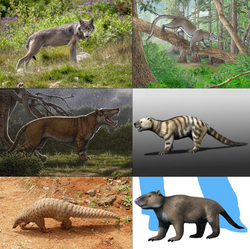Top Qs
Timeline
Chat
Perspective
Ferae
Clade of mammals consisting of carnivorans and pholidotes From Wikipedia, the free encyclopedia
Remove ads
Ferae (/ˈfɪəriː/ FEER-ee, Latin: [ˈfɛrae̯], "wild beasts") is a mirorder of placental mammals[9][10] in grandorder Ferungulata, that groups together clades Pan-Carnivora (that includes carnivorans and their fossil relatives) and Pholidotamorpha (pangolins and their fossil relatives), and extinct order Pantolesta.
Remove ads
General characteristics
Summarize
Perspective
In mirorder Ferae
The common feature for members of this mirorder is ossified tentorium cerebelli and the fusion of the scaphoid and lunate bones in the wrist.[11][12]
forefoot of Patriomanis americana
forefoot of Vulpavus profectus
forefoot of
Thinocyon medius
Thinocyon medius
forefoot of Patriofelis ferox
In clade Pan-Carnivora
The common features for members of clade Pan-Carnivora are:
- heterodont teeth that are sharp and for cutting meat,
- canine teeth that are usually large, conical, pointed, thick and stress resistant,
- and presence of the carnassial teeth.
Carnassials are feature that allows distinguishing the Carnivoramorpha, Oxyaenodonta and Hyaenodonta from the other carnivorous placental mammals.[11] However, these mammals are distinguished between themselves based on the position of the carnassial teeth and the number of molars. The carnassial teeth of the Carnivoramorpha are located in P4 and m1, in Oxyaenodonta are M1 and m2, and in Hyaenodonta and close relatives are M2 and m3. This appears to be a case of a possible evolutionary convergent adaptation toward similar diet.[11]
Remove ads
Classification and phylogeny
Summarize
Perspective
Sister groups to Ferae
According to recent studies, the closest relatives of Ferae are members of clade Pan-Euungulata (group that includes mirorder Euungulata[13][14] and extinct genus Protungulatum). Together they form grandorder Ferungulata.
An alternate phylogeny holds that the closest relative to Ferae is order Perissodactyla, with whom they form a clade Zooamata. Together, clade Zooamata and order Chiroptera form clade Pegasoferae,[15] and Pegasoferae is sister taxon to order Artiodactyla within clade Scrotifera. However, subsequent molecular studies have generally failed to support this proposal.[16][17][18][19][20]
Position of pangolins and creodonts within clade
Pangolins were long thought to be the closest relatives of aardvark and xenarthrans, forming to the now obsolete order Edentata. Research based on immunodiffusion technique[21] and comparison of protein and DNA sequences[22][23][24] revealed the close relationships between pangolins and carnivorans, with whom they also share a few unusual derived morphological and anatomical traits, such as the ossified tentorium cerebelli and the fusion of the scaphoid and lunate bones in the wrist. The last common ancestor of extant Ferae is supposed to have diversified c. 79.47 million years ago.[1]
While there has been strong support in the inclusion of order Creodonta into Ferae, they were usually recovered as sister taxon to order Carnivora.[9] The Halliday et al. (2015) phylogenetic analysis of hundreds of morphological characters of Paleocene placentals found instead that creodonts might be the sister group to Pholidotamorpha (pangolins and their stem-relatives).[25] However, recent studies have shown that Creodonta is an invalid polyphyletic taxon. Members of this group are now part of clade Pan-Carnivora and sister taxa to Carnivoramorpha (carnivorans and their stem-relatives), split in two groups: order Oxyaenodonta on one side and on the other side order Hyaenodonta plus its stem-relatives, genera Simidectes[26][27] and Altacreodus.[28][29][30][31][32]
Taxonomy
Alternative classification and possible fossil members
In Halliday et al. (2015) various enigmatic Palaeocene eutherian mammals have been proposed to be possible members of Ferae, like members of orders Mesonychia, Pantodonta and Taeniodonta, and families Arctocyonidae, Didelphodontidae, Nyctitheriidae, Palaeoryctidae, Periptychidae and Triisodontidae.[25] Mesonychians are proposed to be a sister group to carnivoramorphs, while arctocyonids were polyphyletic, with genera Arctocyon and Loxolophus as a sister taxa to pantodonts and periptychids, Goniacodon and Eoconodon sister to the Carnivoramorpha-Mesonychia clade, and other genera allied with creodonts and palaeoryctids.[25] This enlarged Ferae was also found to be the sister group to order Chiroptera,[25] even though recent studies dispute this classification.[34][35]
Remove ads
See also
References
Wikiwand - on
Seamless Wikipedia browsing. On steroids.
Remove ads








